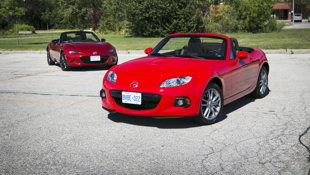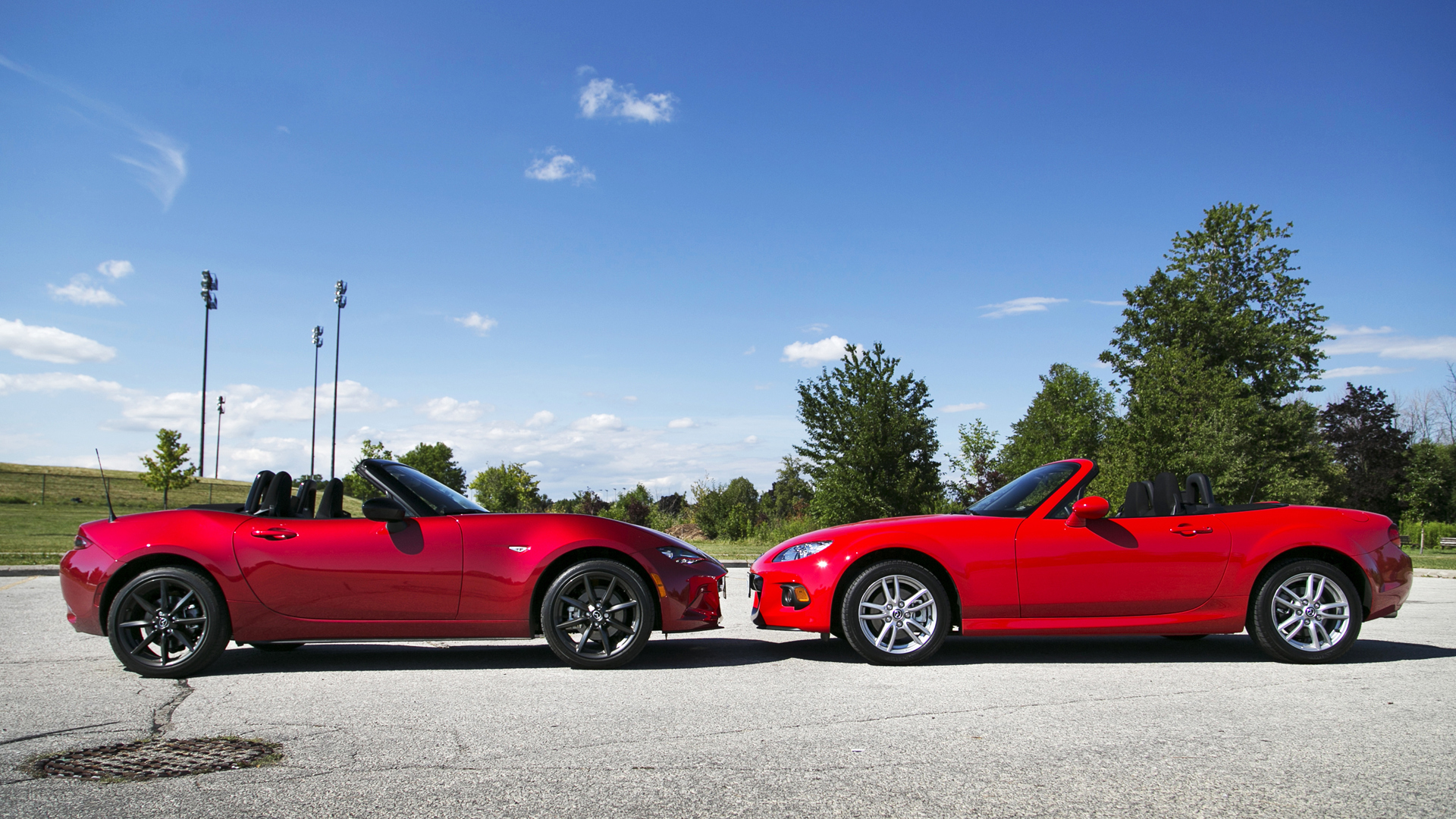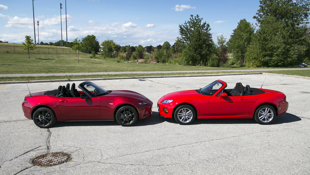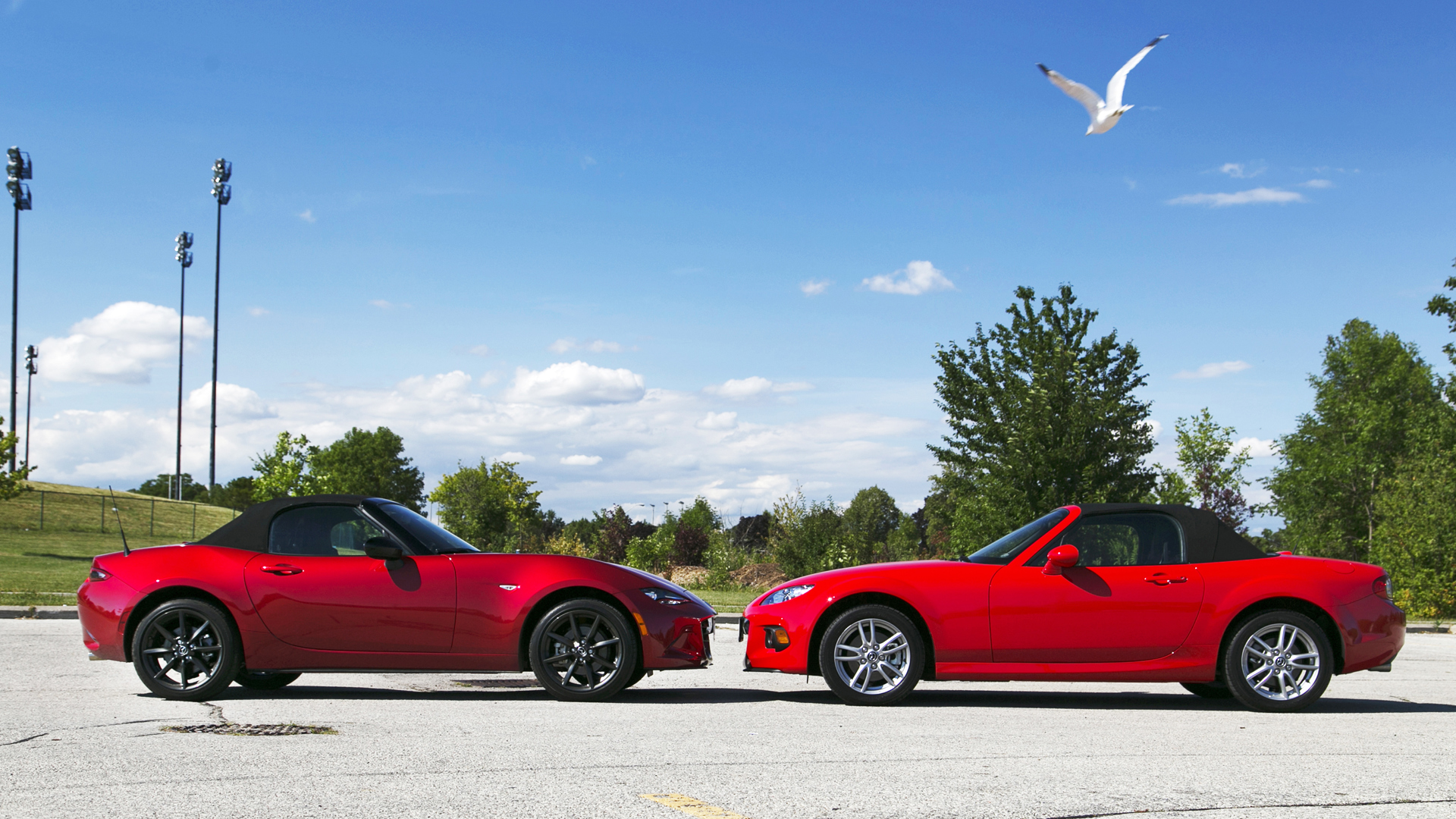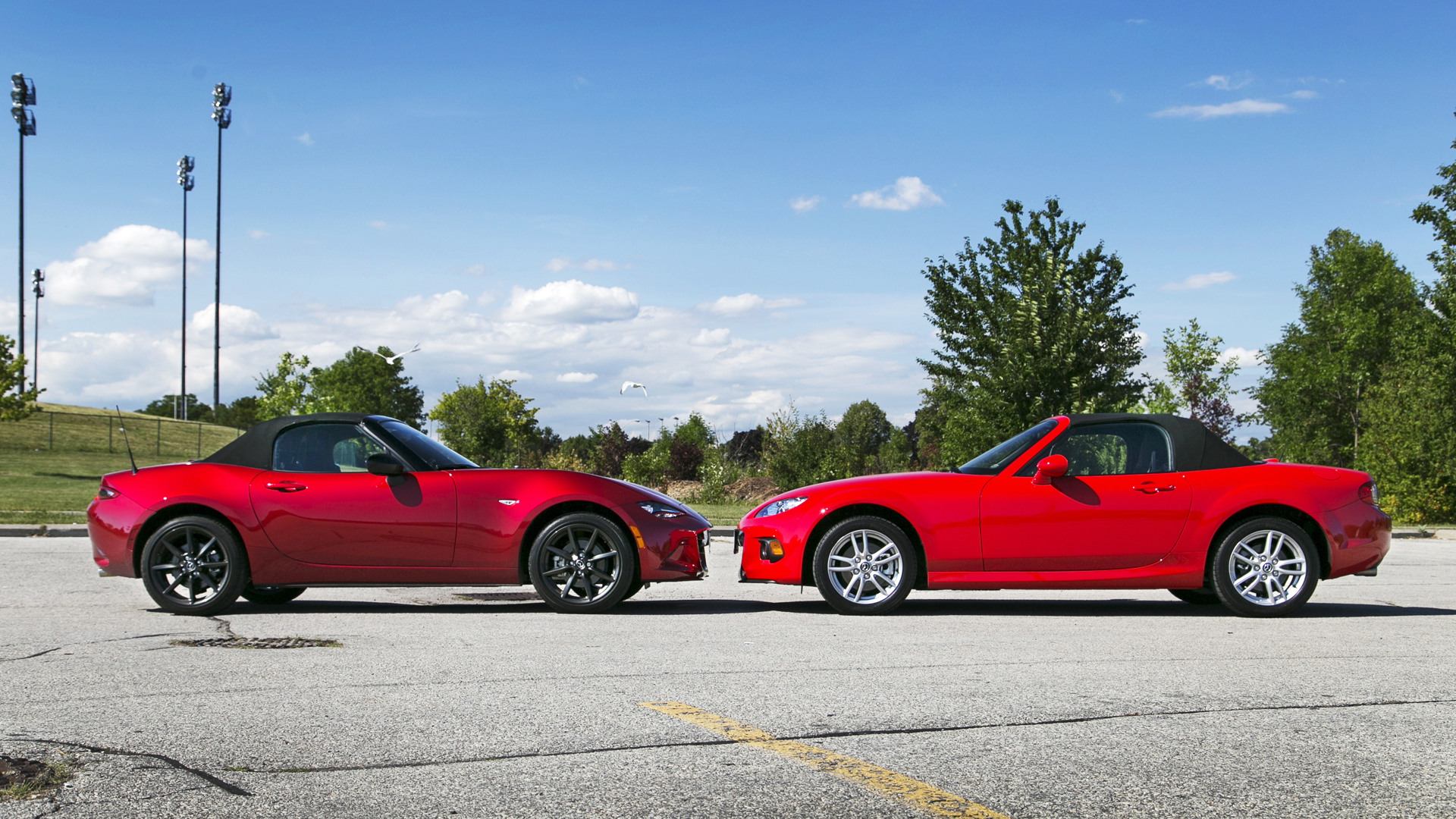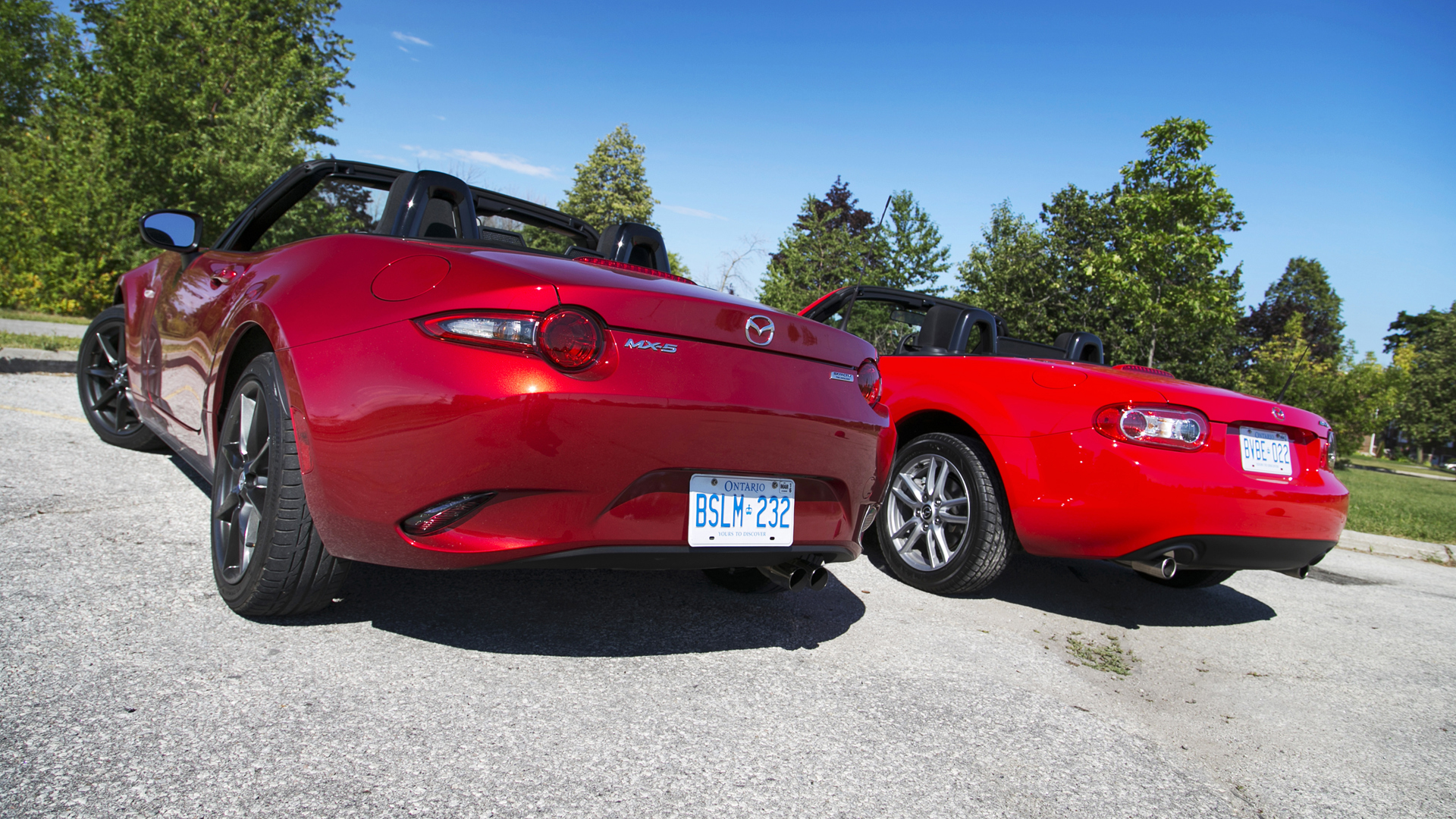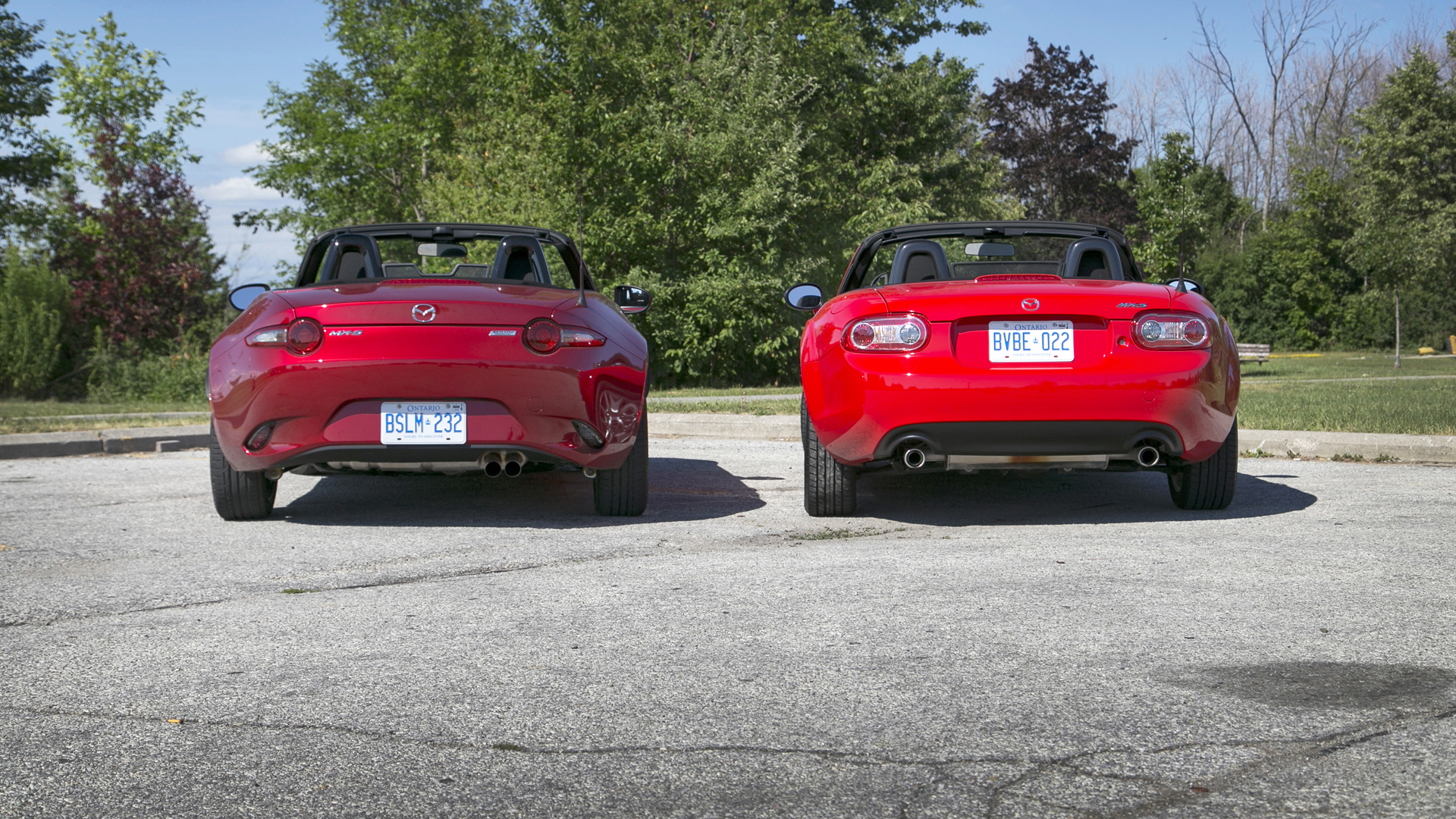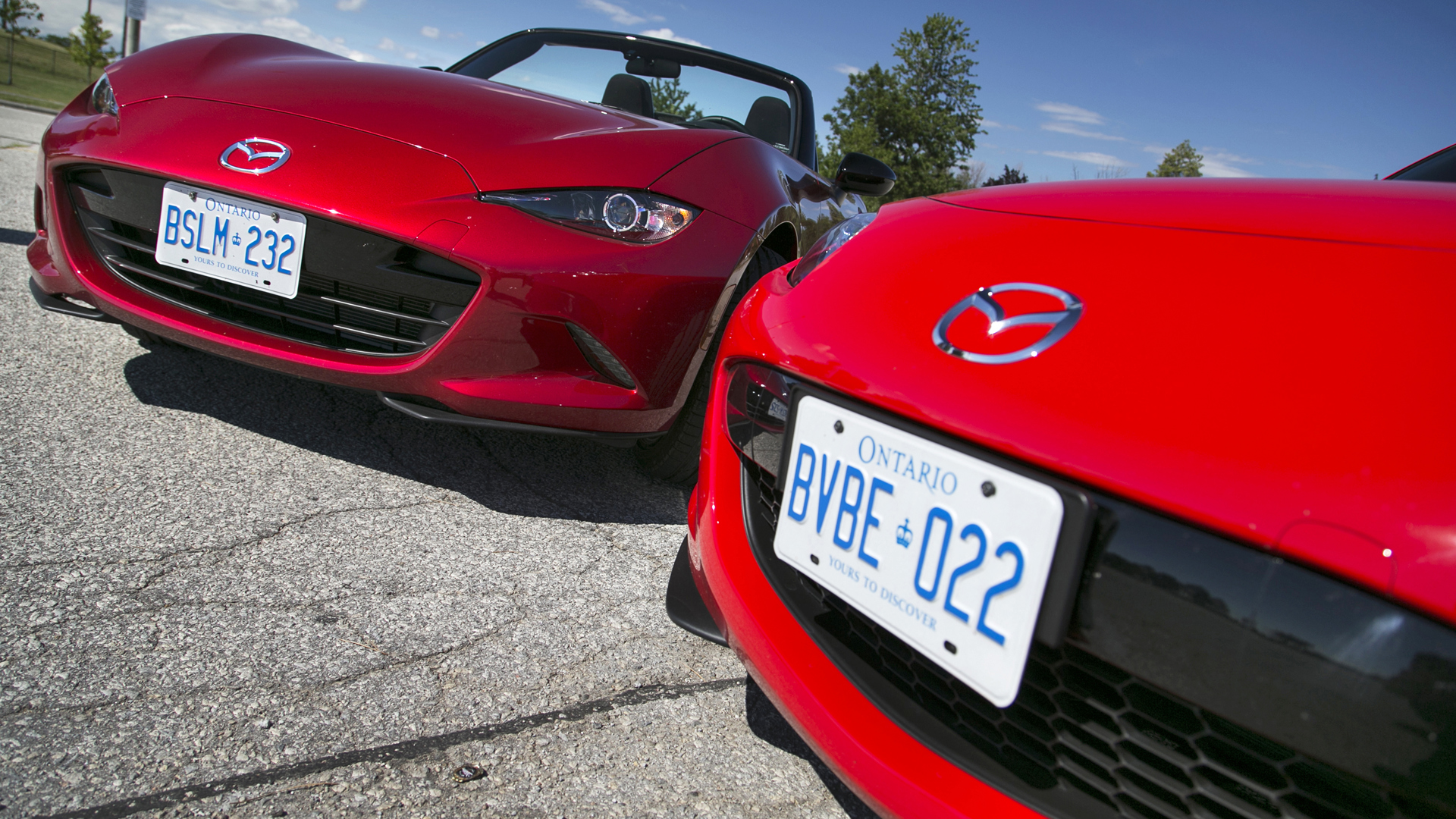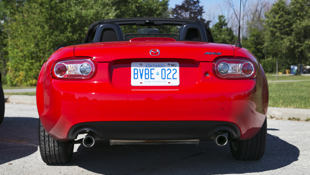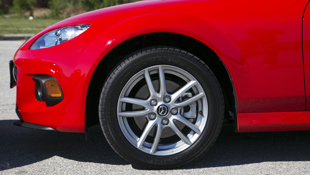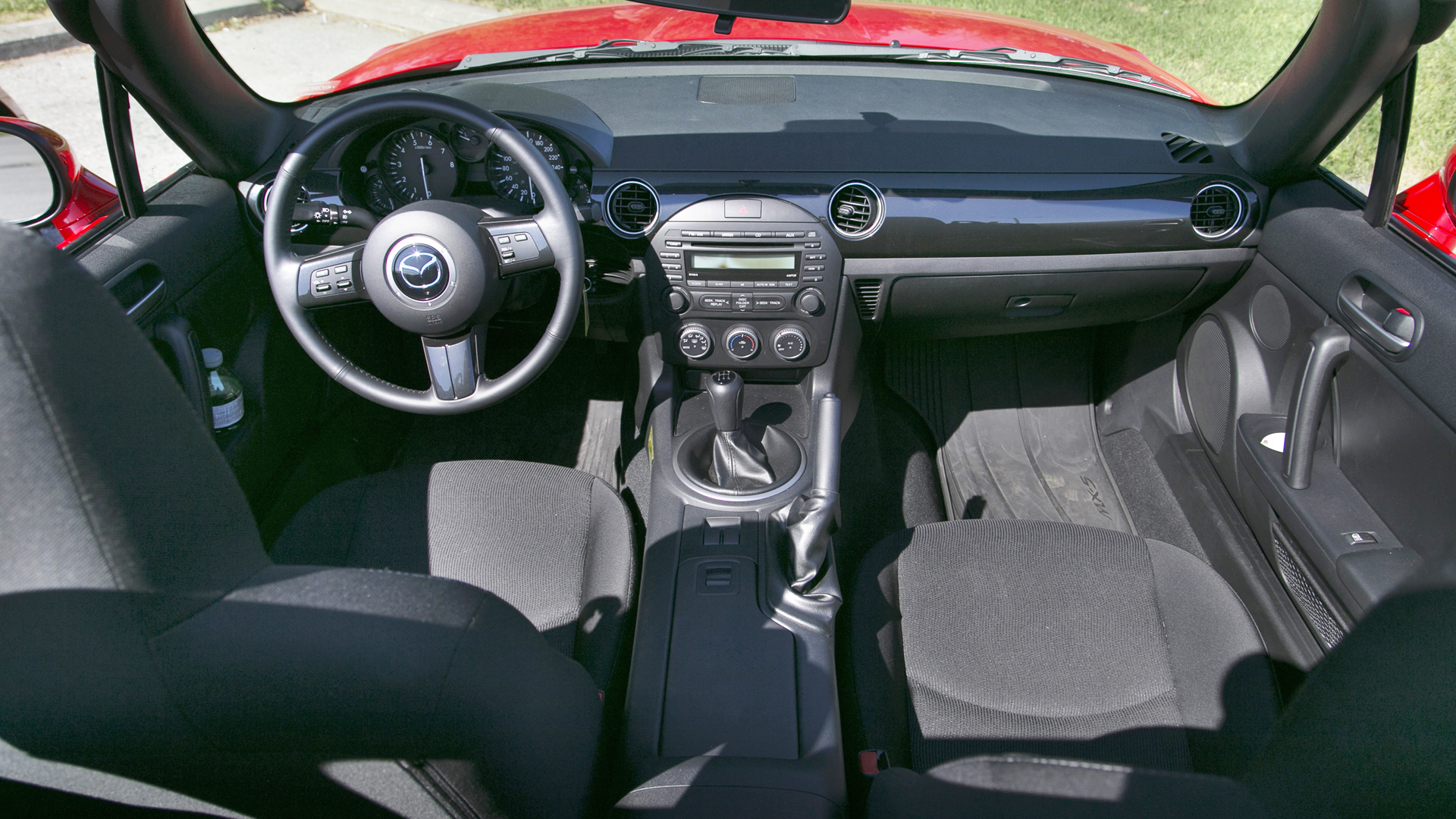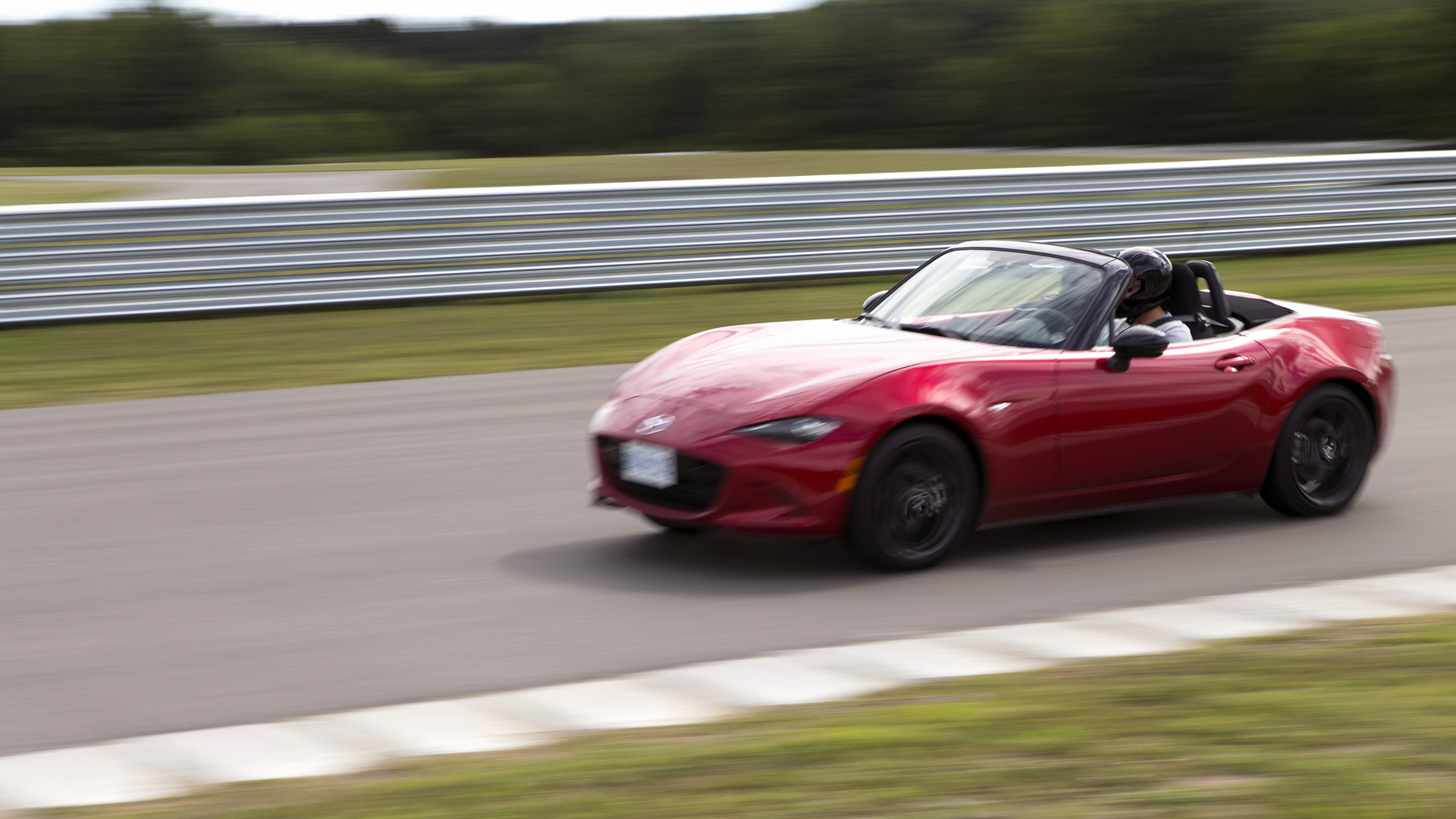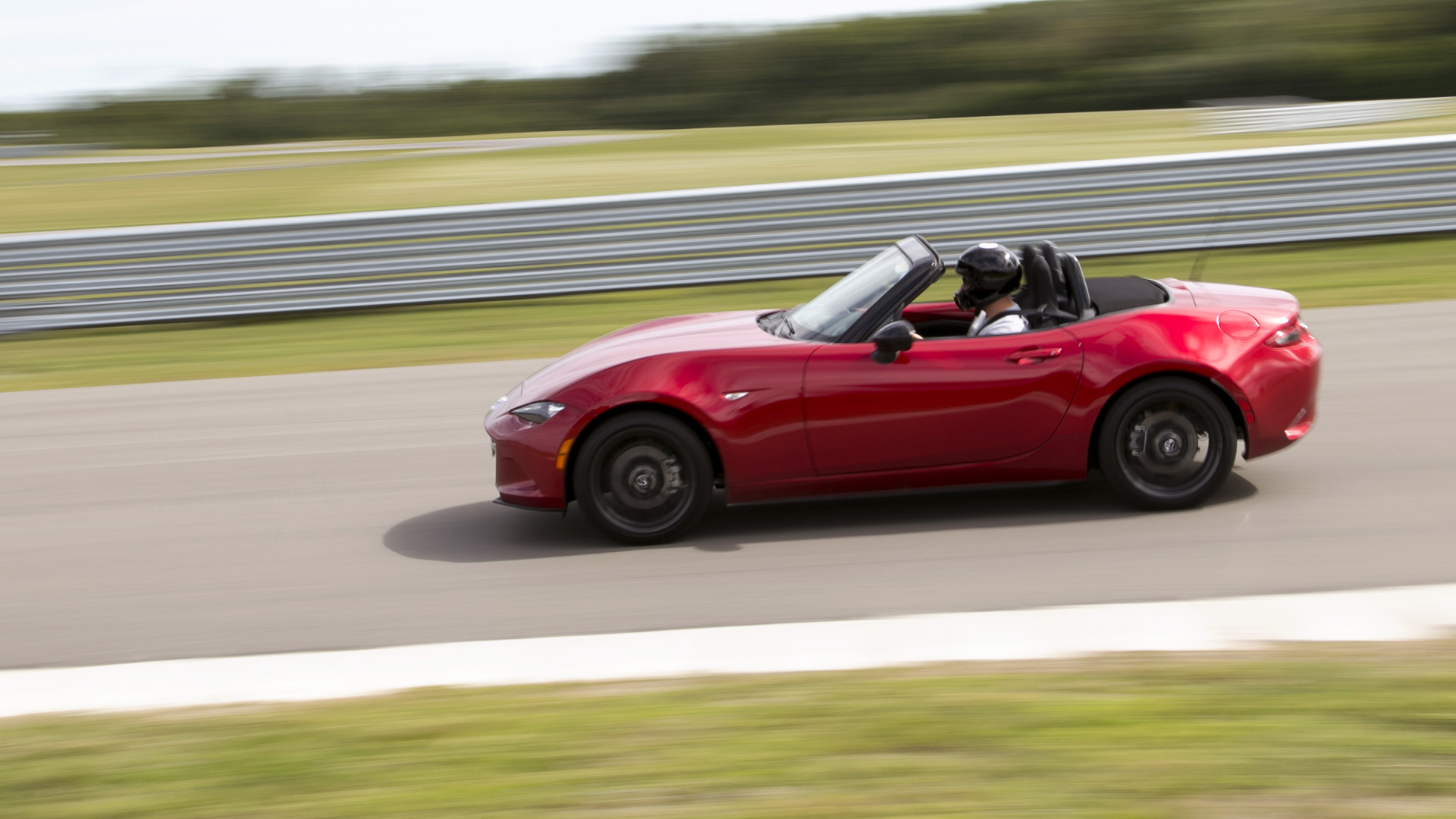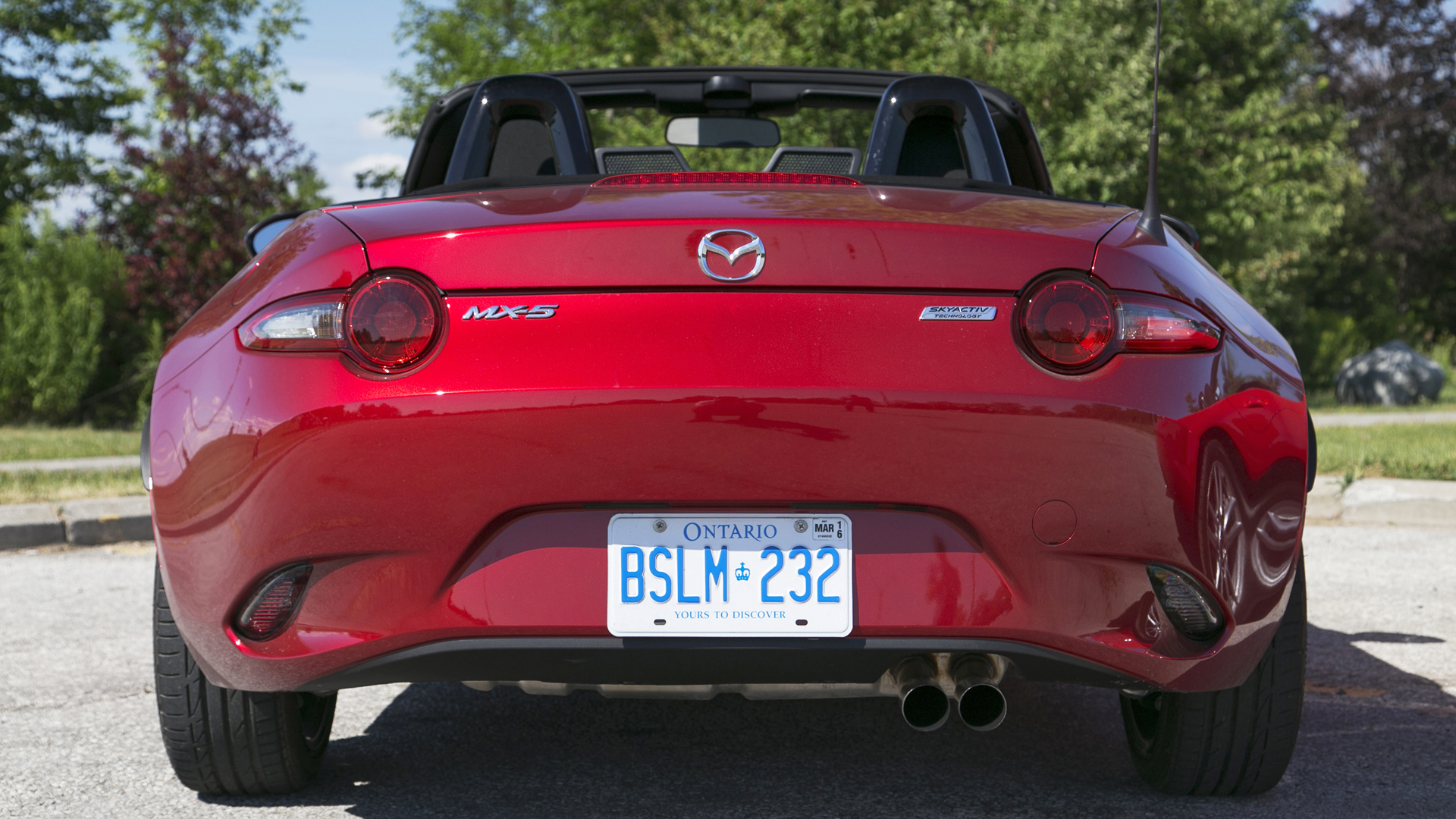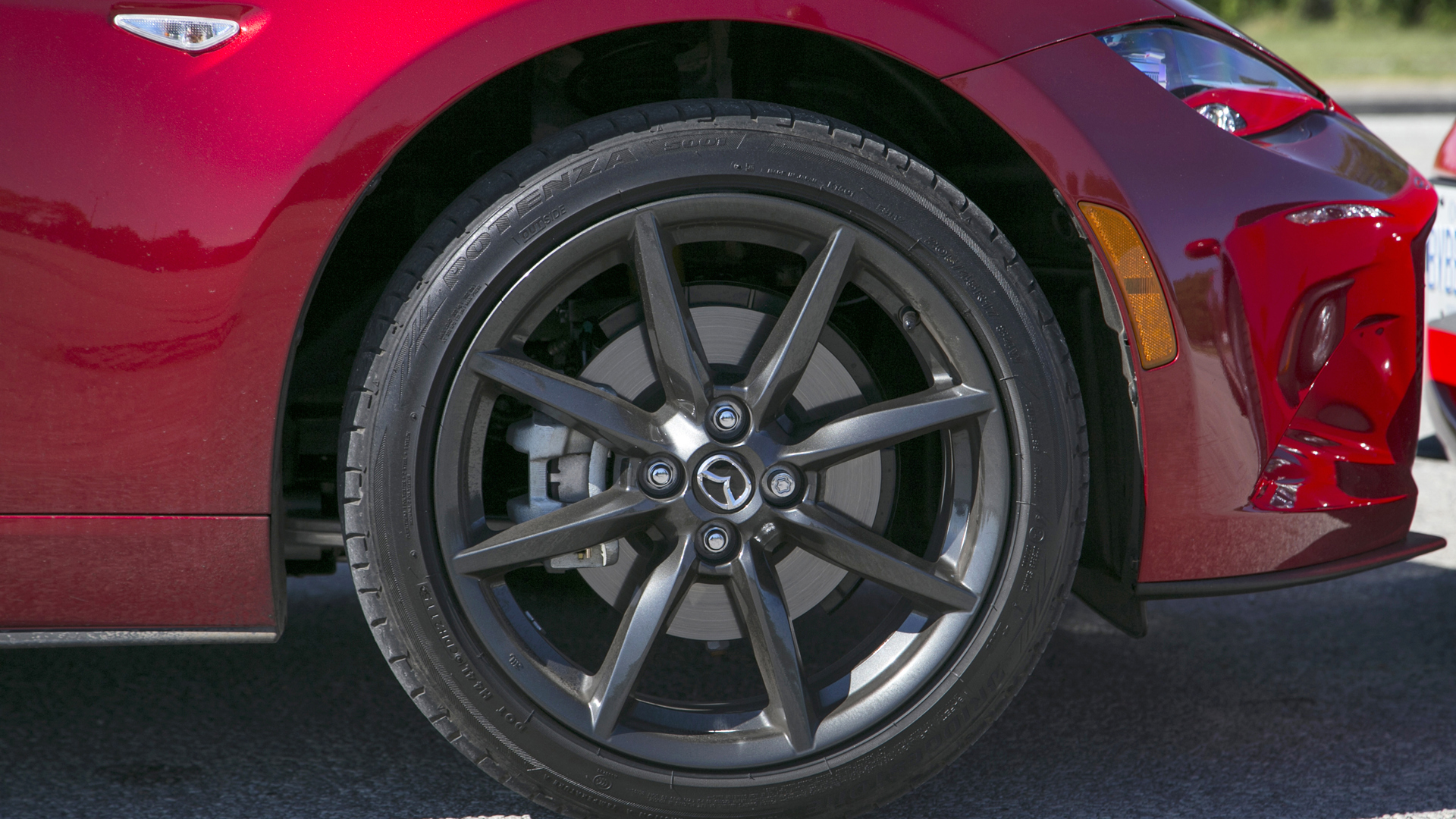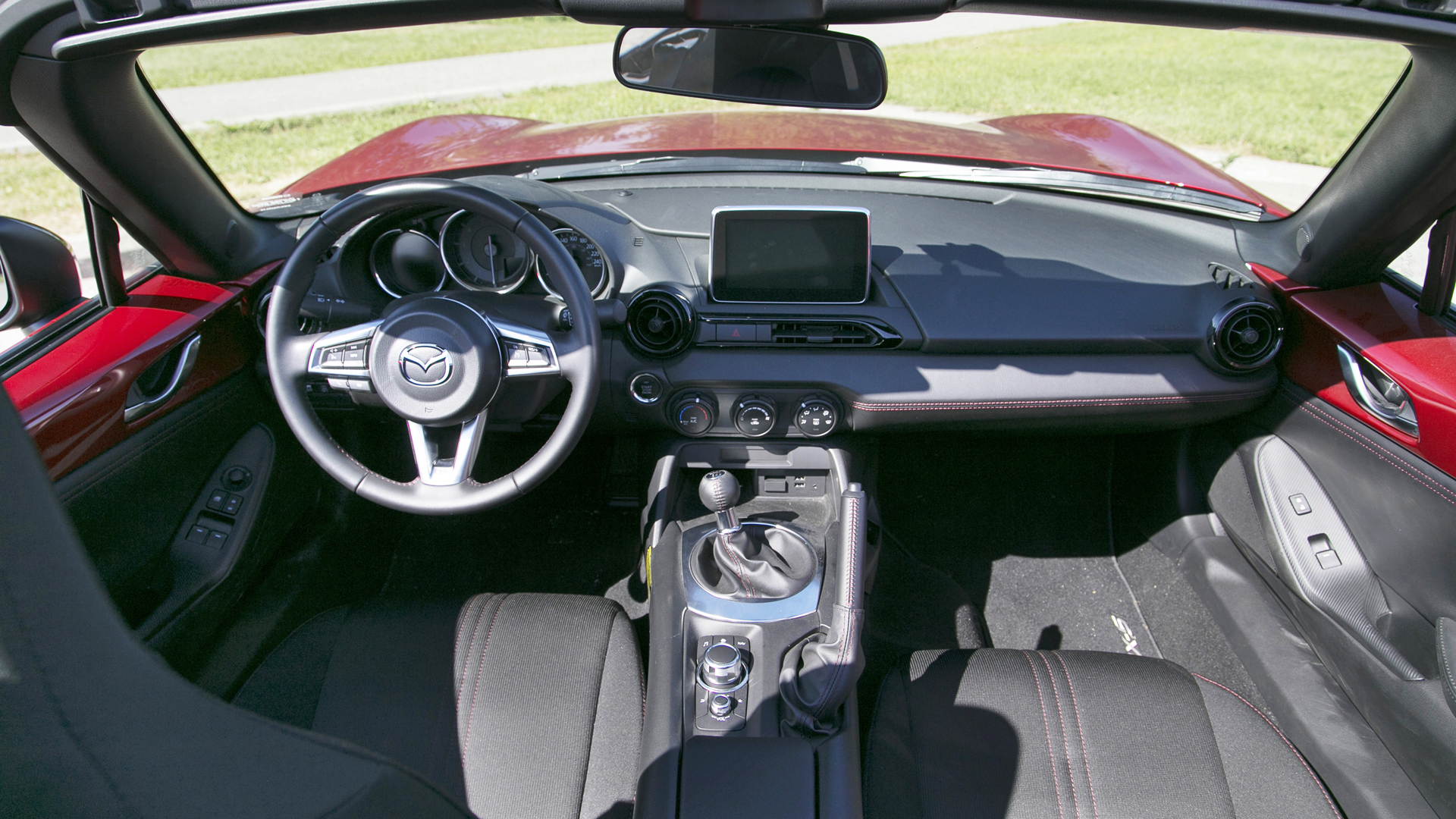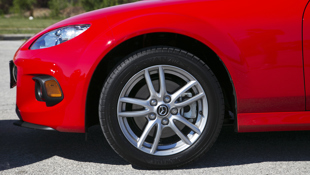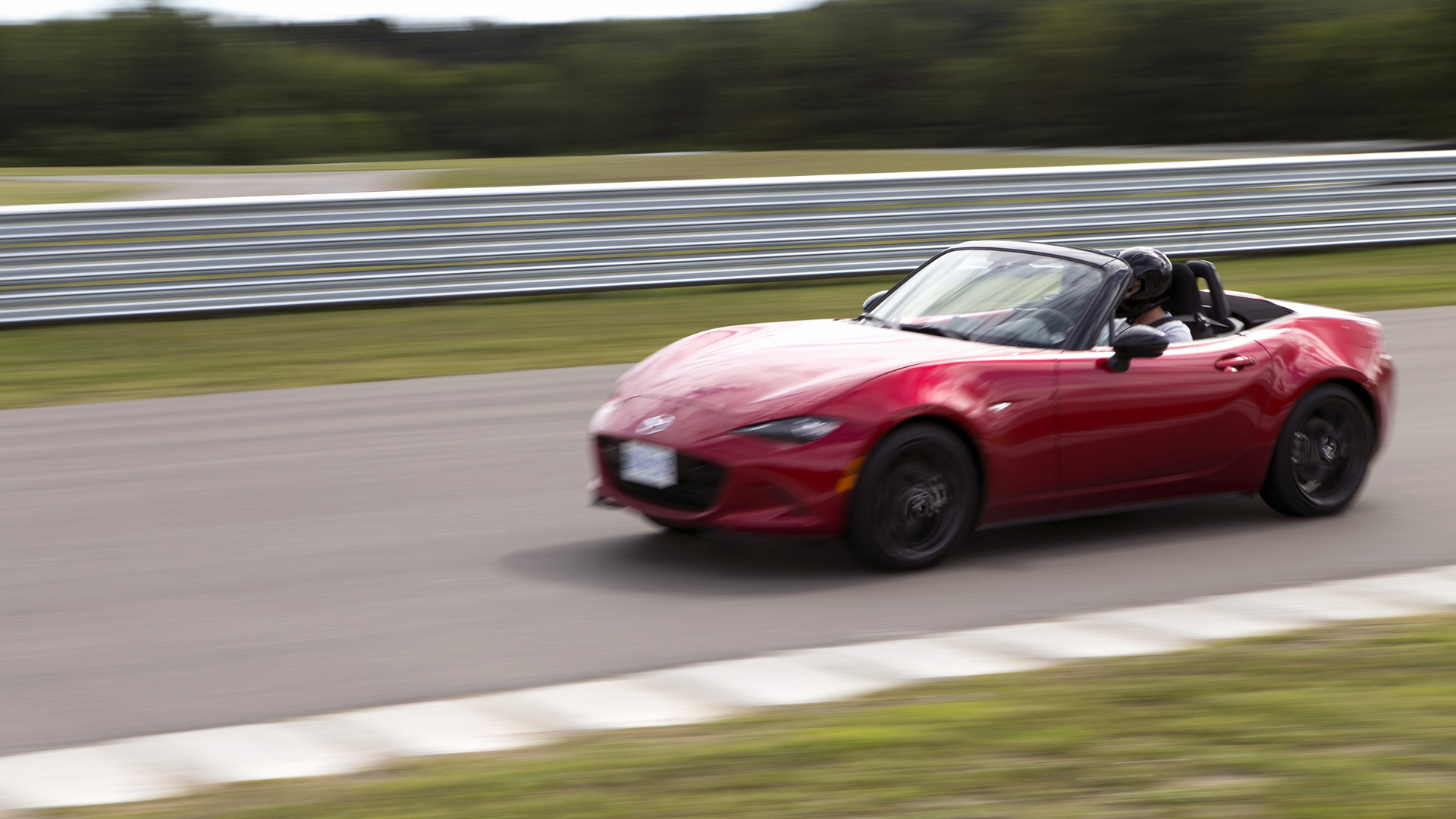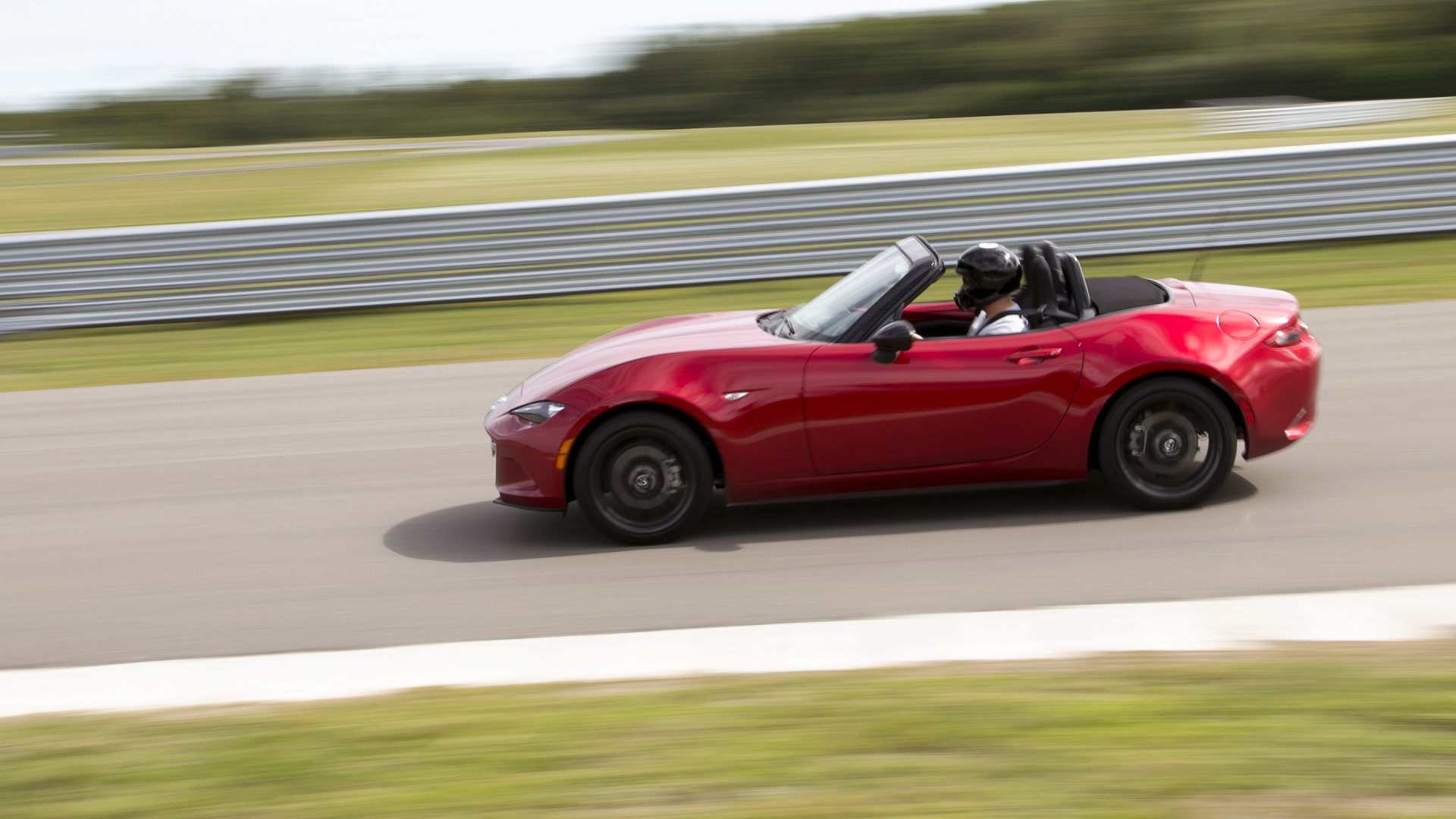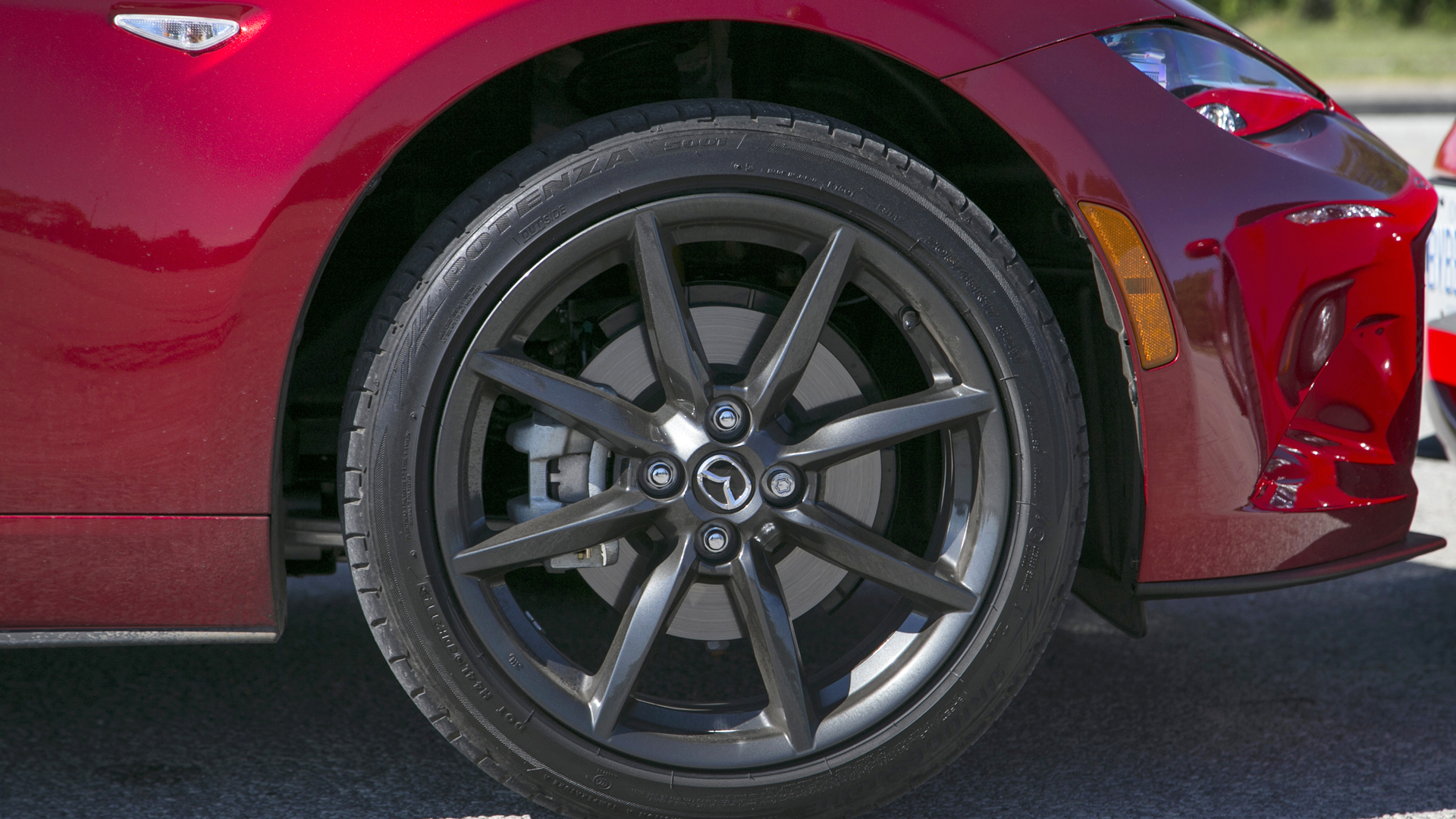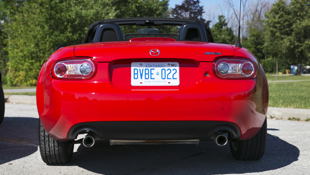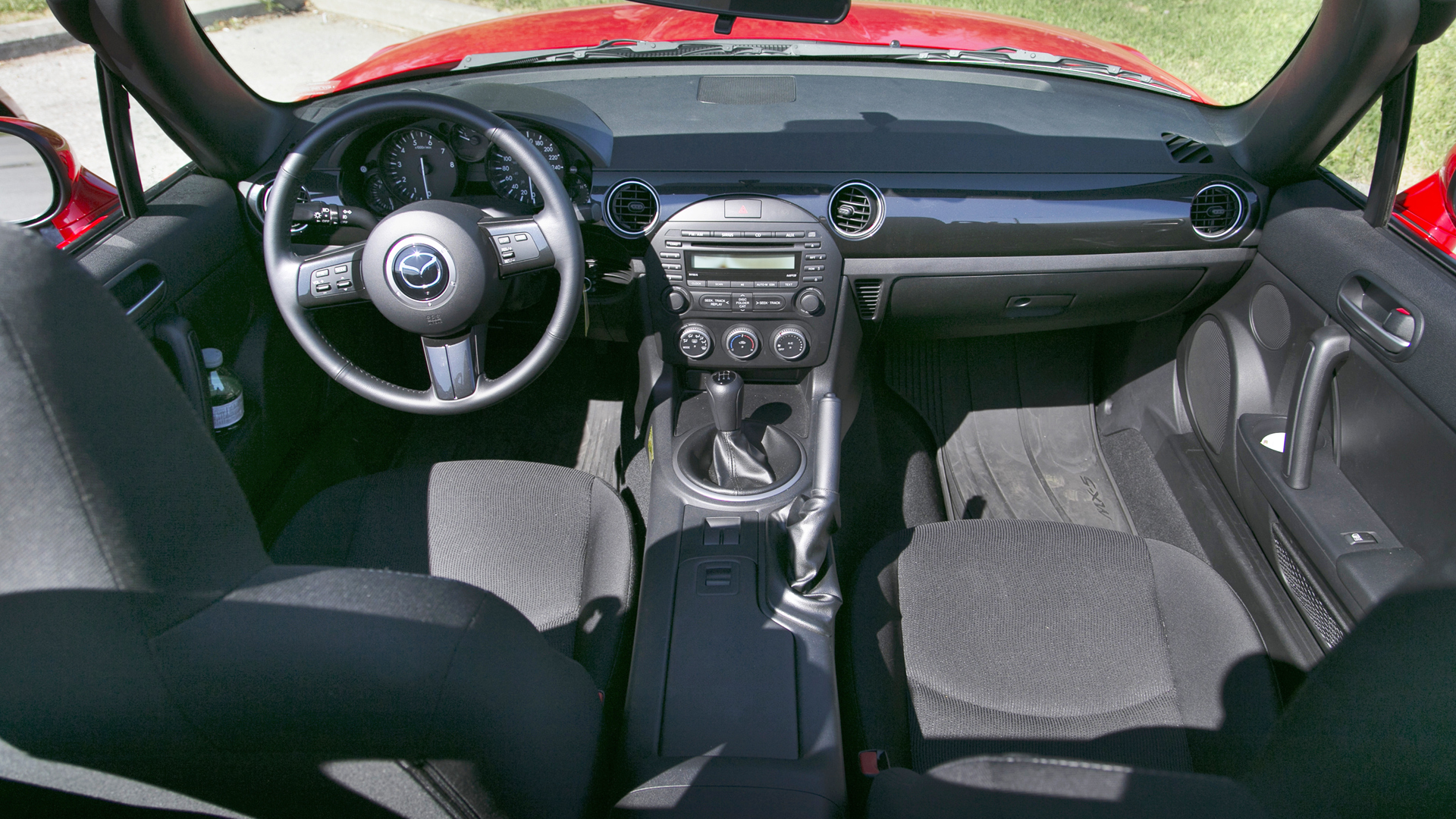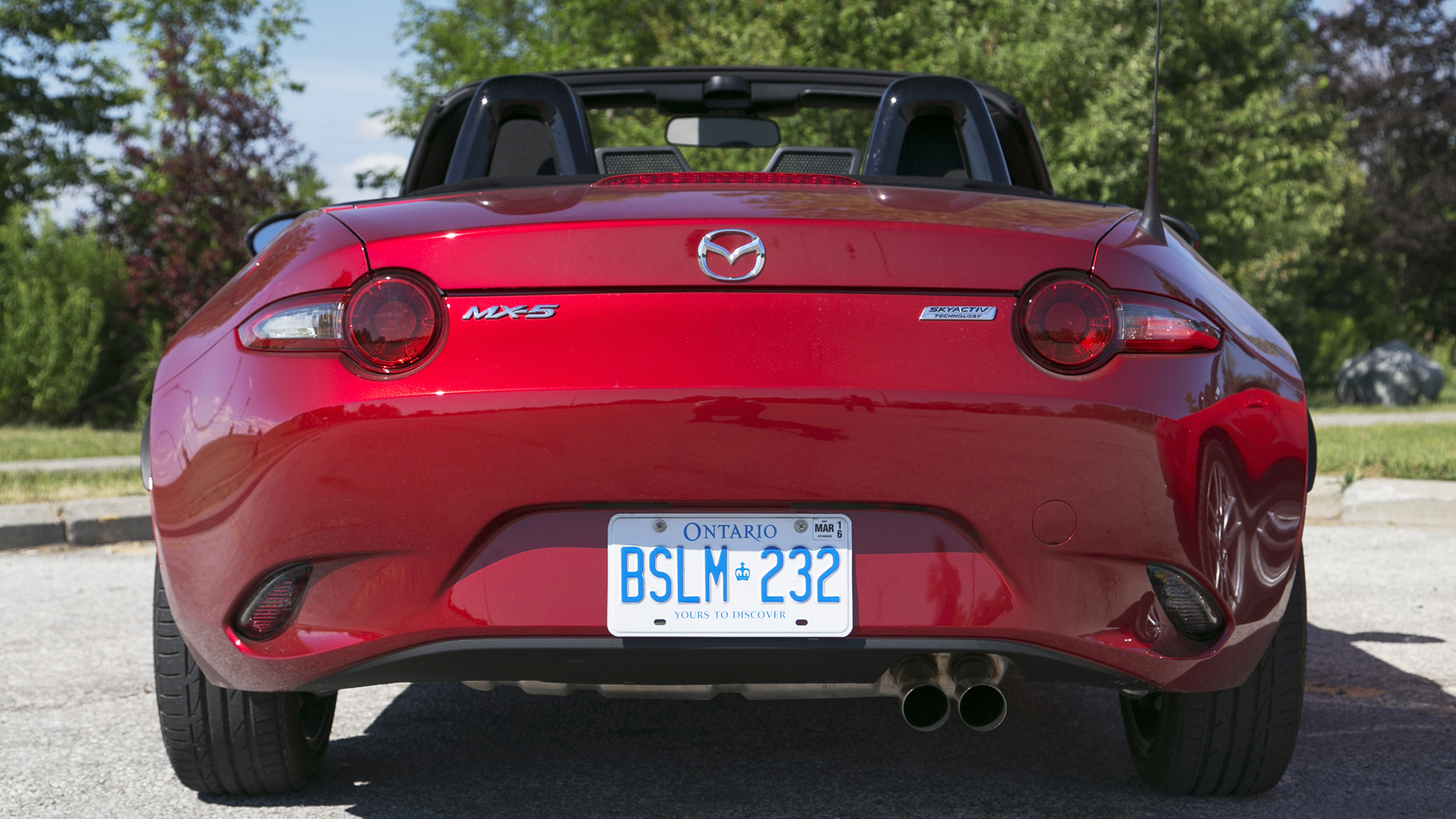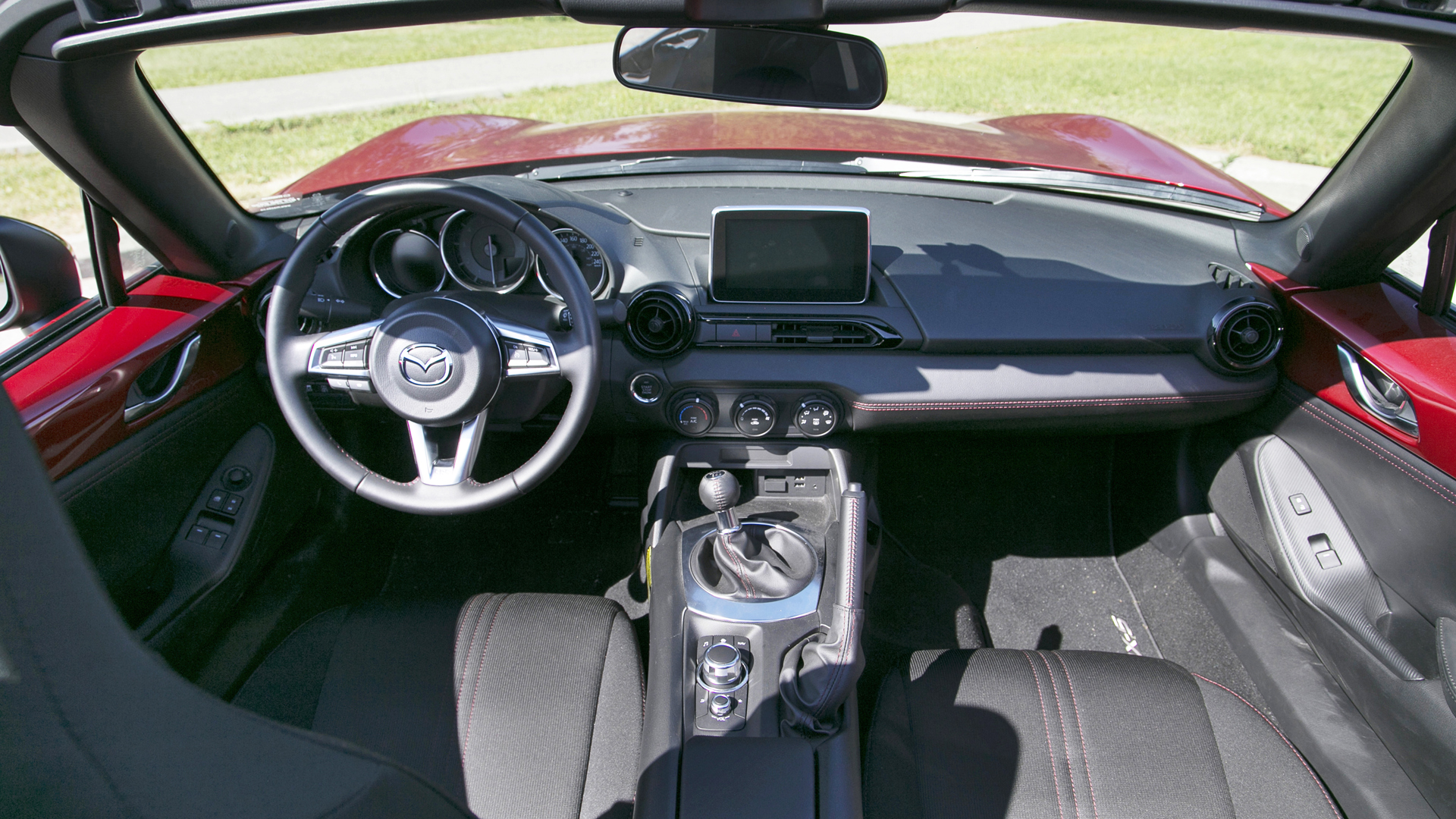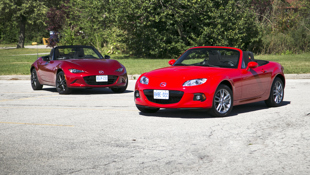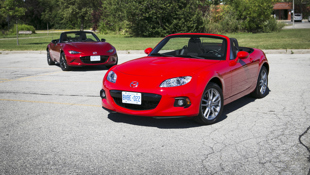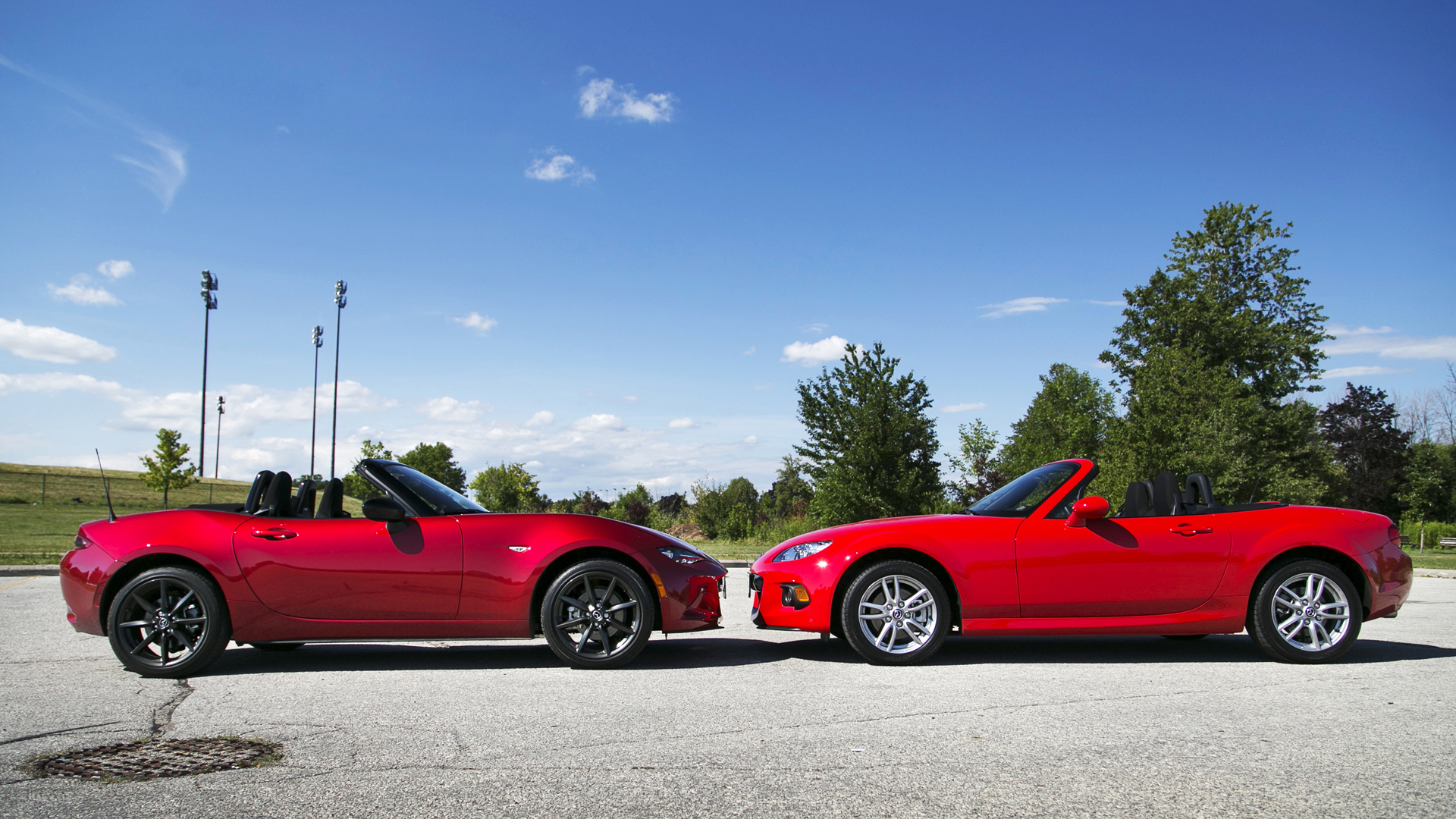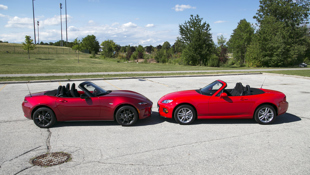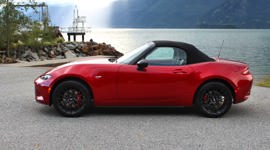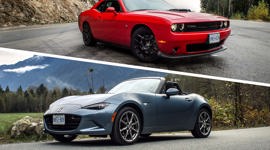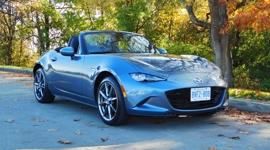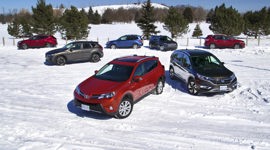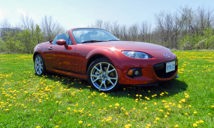Comparison Data
|
2015 Mazda MX-5 GS 6MT
|
2016 Mazda MX-5 GS 6MT
|
|---|---|
|
Engine Displacement
2.0L
|
2.0L
|
|
Engine Cylinders
I4
|
I4
|
|
Peak Horsepower
167 hp @ 7,000 rpm
|
155 hp @ 6,000 rpm
|
|
Peak Torque
140 lb-ft @ 5,000 rpm
|
148 lb-ft @ 4,600 rpm
|
|
Fuel Economy
11.1 / 8.4 / 9.9 L/100 km city/hwy/comb
|
8.8 / 6.9 / 7.9 L/100 km, city/hwy/comb
|
|
Cargo Space
150L
|
130L
|
|
Base Price
$36,045
|
$35,300
|
|
A/C Tax
$100
|
$100
|
|
Destination Fee
$1,795
|
$1,795
|
|
Price as Tested
$37,940
|
$37,195
|
|
Optional Equipment
n/a
|
n/a
|
It was almost exactly a decade ago – autumn, 2005 – when I first got my hands on the keys to the then-brand-spankin’-new third-generation (NC) Mazda MX-5 and motoring as I knew it would never be the same again.
Miatas – diminutive compared to most everything else on the road, and relentlessly fun.
I had previously driven earlier versions of Mazda’s venerable little roadsters, but this car, no longer labeled a Miata here, was bigger, more muscular-looking and was powered by the brawniest engine Mazda had fitted yet (brawny being a relative term here). Within the first kilometre of that first drive, I was sold, and promptly returned to the dealership to fill out the paperwork.
Having had a string of luxury-brand German sport sedans that provided occasional bouts of reliability, I was ready for a big change. My commute had expanded and the promise of the MX-5’s fuel efficiency was almost as enticing as its expected reliability. At least that’s how I pitched it to my wife, trying to justify the tiny, rear-wheel-drive convertible as my everyday car for all seasons. Fortunately, she saw the giddiness this toy of a car instilled and put up no real fight.
I only managed to keep it for four blissful years until the reality of adulthood (aka the birth of my son) required me to return to the world of sport sedans. Of all the cars I’ve had – and there have been some really great ones – that black 2006 MX-5 GS still stands out as my favourite. I loved that car.
Between tantrums and when not eating the last of my cereal, my son is pretty great too, so I guess it was a reasonable tradeoff.
The reason the MX-5 Miata is so passionately adored by drivers nostalgic for ‘60s British roadsters (but not their cantankerous electrics); by countless racetrack-thrashing enthusiasts; and by me, is simple. In fact, it is simplicity that makes the Miata a winner. Mazda dialed in the formula of “Light = Right” with the first-gen (NA) Miata in ’89 and have maintained it to varying degrees ever since. It was tiny, it was not powerful, but it was balanced and light. This makes them sensational fun on both the road and the track, where they have proven to be competitive, durable and economical to campaign.
When the second generation (NB) Miata arrived, fans of the NA generation moaned and whined that the new car had lost some of its soul by becoming more refined, more powerful, bigger and (gasp!) heavier. Then when the NC arrived, both the NA and NB owners complained.
Of course “larger” and “heavier” were only relative to the preceding model, but the reality was, the newer cars were still truly Miatas – diminutive compared to most everything else on the road, and relentlessly fun.
This time round, Mazda has given the Miata fans absolutely no reason to moan about size and weight of the new car. The ND you see here is both smaller and lighter than the NC MX-5. And it’s less powerful.
Wait, what? Less powerful? Isn’t that a backwards step for a modern sports car? Normally, yes, it would be, but the new MX-5 is anything but a normal car. Mazda’s engineers stripped away 124 kilograms of superfluous bulk if we compare a 2015 to a 2016 in equal GS trim. That’s almost 125 kg shaved from a car that has more features and more interior space than the old model. Engineering? Heck, this is wizardry!
And even though technically the new car puts out less peak horsepower (155 versus 167), it does so with fewer revs and produces more torque (148 versus 140) at fewer revs as well. This means that the new MX-5 actually makes more power lower down on the tachometer than last year’s MX-5, right when you’ll feel it most of the time.
The net result is a 2016 MX-5 that accelerates quicker, turns sharper and brakes harder than the already remarkable car it replaces. Quite simply, no car that costs anywhere near what the new MX-5 provides such an engaging, visceral and precise driving experience.
Both the ND and NC come with 205/45/17 summer performance rubber when specced as GS trim cars in Canada (our NC tester was a base model GX with sloppy-feeling 16” Yokohama Advan A11a tires), which, when driven back to back, helps showcase just how much the evolutionary suspension and handling tweaking has improved the MX-5. The weight saving again plays a huge role here (did you know the wheels on the MX-5 are now 4-bolt instead of 5?), in giving the new car a remarkably light-on-its feet feeling.
Body roll is not insignificant, but on the track, the new Miata rolls a bit, takes a set and remains wholly predictable. Even with its minimalist rubber by today’s standards, it still offers suitable grip for turning and braking duties. Not that it’s at all a heavy or sluggish car by any means, but in comparison, last year’s MX-5 feels like an athlete who maybe ate a little too much over the Christmas holidays and needs to get back to the gym.
It seems ridiculous to me to even write that last sentence. My MX-5 was a tireless puppy who wanted nothing more than to fetch redline, no matter how many times I tossed it out to retrieve. Every simple errand became a qualifying event for the next great race in my imagination. But this new car, it’s just simply better. More eager, more capable. More confidence inspiring.
But it’s not just the performance where the ND has a leg up on the NC. Even in the looks department, the new car has next level styling. There is clearly a family resemblance to the Mazda3 in the front, and that’s only good news since Mazda’s compact is arguably the best looking car in its segment. The ND, with it’s squinty eyes looks a little angrier in its visage than the NC’s gaping “aw shucks” smiley face, and in person, seems to sit a little lower on its haunches, though the photos here beg to differ. Oh, and there are subtle fender arches, imperceptible from the profile, that are visible from the driver’s seat and help the pilot place the corners of the car with greater precision at speed.
In the rear, the tailpipes are now paired up side-by-side in a small cutout on the right, instead of the two widespread outlets serving a pair of mythical cylinder banks in the NC. The taillights are as squinty and sinister as the headlights, but there’s something about the overall rear of the car that just doesn’t work for me, though I can’t really put my finger on what it is. The NC appears a little wider (even though it’s not) and squatter (again, nope) than the ND. I’m sure the ND’s derriere will grow on me over time, and for what it’s worth, my colleagues and the several fellow motorists who commented on the ND’s styling triumphs clearly have no issue with it as is.
Jumping from the driver’s seat in the NC directly to the ND is a revelation. The styling is fresh and updated, highlighted by the iPad-on-the-dash multimedia interface (familiar to Mazda3 owners). Thanks to both touchscreen and a rotary knob, using the system, including the navigation (standard on GS and GT trim cars) is fairly straightforward. Such a feature wasn’t an option on the NC MX-5 – in fact, our GX press car didn’t even have Bluetooth connectivity, which is surely the only new car I’ve driven in the last 3-4 years that doesn’t have it.
The materials are of an obviously higher quality than before. There are more padded and soft touch spots where your elbows and forearms might come in contact, and the red accent stitching is a sexy touch too. The upper portions of the door are finished in body-coloured plastic that helps it feel like a retro roadster, contemporized.
A traditional glovebox is no longer found in its usual spot in front of the passenger. Instead, the cubby between the passengers’ shoulders has been expanded to greater capacity and doesn’t contain the fuel door release switch as it previously did (the ND has a click-to-open door that locks when the car’s door locks are activated, like most new cars).
The biggest cockpit improvement deals with the top. While I had become fairly adept at raising or lowering my NC’s top, even while tootling along at idle speed, without so much as taking my eyes off the road, the new top is even easier to open or close. The new top seems to slide forward more than rise up, creating less drag in the wind while moving, and less resistance on the operator’s shoulder. It really couldn’t be simpler, and will hopefully negate the need for a weighty and complex power hard top like the up level NC models had last year.
Mazda has added performance, content and of course lightness, yet reduced the cost of the comparably trimmed MX-5 for 2016. This car is not only uniformly better than last year’s model (except for the tiny reduction in trunk size), it is absolutely one of the preeminent and most exciting new cars available today.
The NC generation MX-5 remains the best car I’ve ever owned, but it instantly feels dated and sluggish compared to this new car. And while I get that not everyone can live with a tiny, two-seat roadster for their own daily driver, I can say that if you think you don’t like the new MX-5, it’s simply because you haven’t driven it yet.
| Model | 2015 MX-5 GS 6MT | 2016 MX-5 GS 6MT |
|---|---|---|
| Engine | 2.0L DOHC I-4 | 2.0L DOHC I-4 Skyactiv |
| Horsepower | 167 @ 7,000 rpm | 155 @ 6,000 rpm |
| Torque | 140 @ 5,000 rpm | 148 @ 4,600 rpm |
| Length (mm) | 4,032 | 3,914 |
| Width (mm) | 1,720 | 1,734.80 |
| Height (mm) | 1,255 | 1,240 |
| Weight (kg) | 1,182 | 1,058 |
| Wheels | 7 x 17" | 7 x 17" |
| Tires | P205/45WR17 | P205/45WR17 |
| Fuel Cons. City | 11.1 | 8.8 |
| Fuel Cons. Hwy | 8.4 | 6.9 |
| Fuel Cons. Comb. | 9.9 | 7.9 |
| Cargo (L) | 150 | 130 |
| MSRP $CAD | $36,045 | $35,300 |

